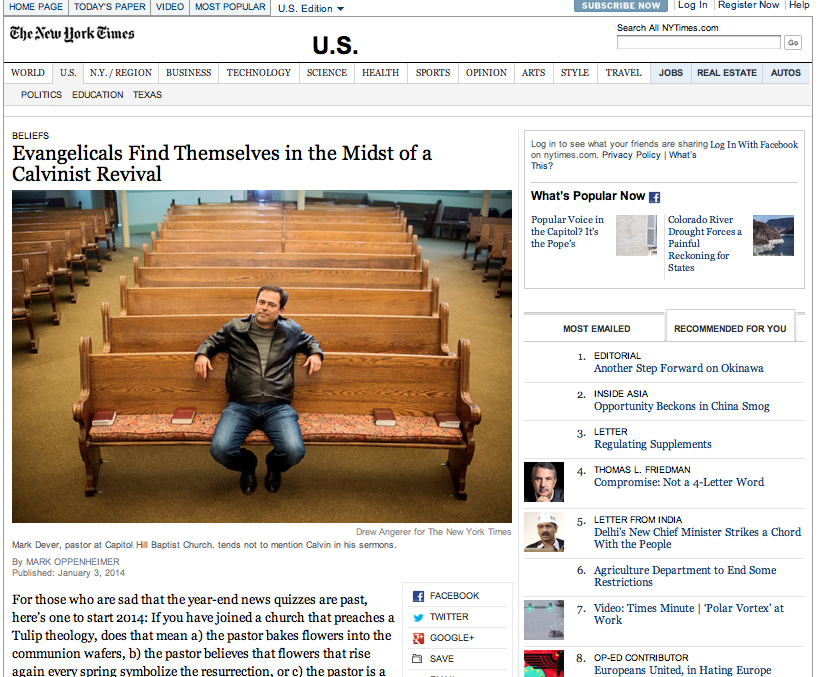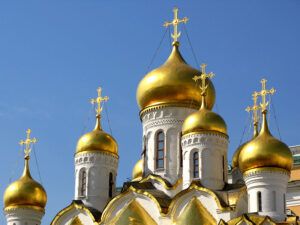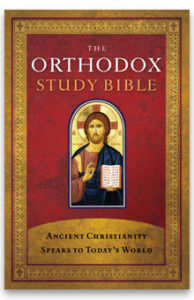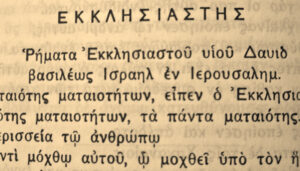On 30 December 2013, W. Bradford Littlejohn published “The Search for Authority and the Fear of Difference” in The Sword and the Ploughshare. He began by noting how he learned second hand (??) about a longtime Reformed Christian who decided to convert to Eastern Orthodoxy because “he needed someone to submit to” (quotation marks in the original text).
It struck me that among the many evangelicals and Reformed folks converting to Rome or Orthodoxy, this was a common story. “We Protestants, we’re so divided, we’re so individualistic, we have no sense of authority, we have to make up our own minds about everything rather than submitting to the judgment of others. It’s time to stop trying to do all the thinking for ourselves, and submit to authority and tradition.” And then it struck me that, while this sounds superficially humble, pious, and mature, it starts to look considerably less laudable when you put it in other terms. “It’s time to stop taking responsibility for my own commitments and value judgments and let someone else make those difficult determinations for me.” “The commitment to faith and obedience is what’s important, not the content, so I should just leave the question of content to others and focus on relinquishing self-will.” “It’s too much work being expected to think for myself amid all these different questions and options, so I think I should just check my brain at the door, and embrace a set of ready-made answers.” Now I don’t mean to be too harsh, of course, on all those who make such moves, and there is certainly a balance; some of us are too arrogantly insistent on making up our own minds about everything, and need to learn to defer to the judgment of others on occasion. But despite how often we tell ourselves in conservative Protestant circles that this is our big problem, I am not at all convinced that it is, at least for us Reformed in particular.
(Emphasis added)
On first reading this article I was struck by Littlejohn’s quotation marks. The use of quotation marks implies that he actually heard the convert give the reason for changing churches. One of the commenters, David, asked whether Littlejohn was quoting a real live convert or was making up these quotes as a foil to make a point. The answer proved to be very enlightening.
Of course, I am not directly quoting any one convert, but I am offering what I think is a faithful composite sketch of cases I’ve encountered or read about. To be sure, I don’t pretend to be giving anything like a full phenomenology of conversion, or a one-size-fits-all account of what’s motivating everyone. That said, I am convinced that this is part of what is going on in many cases.
While I do agree with Brad Littlejohn that “checking my brain at the door” is a poor reason for converting to Orthodoxy, sadly there is no real person behind Brad’s quotes here – he just made them up. [Do Reformed converts “check their brains at the door” of their conversions, and are they prone to “deceive themselves”?]
The question I have is this: Do those who convert to Orthodoxy actually stop thinking and just submit to authority as Littlejohn claimed? Many converts will protest that they don’t quite fit his description; Littlejohn’s response is that the converts are prone to deceive themselves.
If you mean that you’ve never encountered anyone who put things in terms of the quotes further on in the second paragraph—well of course not, that’s the point. No one actually thinking that way is going to admit to themselves that that’s how they’re thinking. And so it’s not surprising to me that most converts would deny fitting my description here. To be sure, we need to listen to the reasons converts are actually giving—and I am attempting to do that here, more than many I’ve heard who have tried to diagnose the cause of such conversions—but we needn’t take those reasons at face value. Quite often we are very poor judges of our own motives, often worse than others watching us, in fact. We are very prone to deceive ourselves and make ourselves sound much more patient and objective and rational and humble than we really are. (Emphasis added)
Littlejohn’s assertion that he knows better than the converts is highly problematic. At the Final Judgment the secrets of our hearts will be revealed and each one of us will have to give an account for our life, our thoughts and deeds (Romans 2:12-16).
So the best approach is not to second guess people’s motives (or put words into our mouths in the form of quotes) but to present biblical, theological, and historical evidences for a reasoned discussion about conversions to Orthodoxy. The insinuation that people who converted to Orthodoxy “checked their brains at the door” comes close to an ad hominem attack and for that reason is to be avoided. Questioning people’s motives in effect muddies the water and poisons the well of public discourse. It is far better and more charitable if we take people at their words than to question their motives.
Why People Convert to Orthodoxy
While Littlejohn’s assertion may come across as controversial and even objectionable, the main issue here is: Does he have the evidence to back it up? Apparently not. Are there any scholarly studies out there that shed light on conversions to Orthodoxy? The answer is: Yes, there’s Amy Slagle’s 2008 dissertation “’Nostalgia Without Memory’: A Case Study of American Converts to Eastern Orthodoxy in Pittsburgh, Pennsylvania” (University of Pittsburgh, 2008). The advantage of Slagle’s dissertation is we have here solid data for evaluating Littlejohn’s argument. Note: Her dissertation is now available in book form: The Eastern Church in the Spiritual Marketplace: American Conversions to Orthodox Christianity (published by Northern Illinois University Press, 2011).
 Slagle interviewed forty people who lived in the Pittsburgh area (p. 43). She used a guided questionnaire and ethnographic participant observation to gather data. In addition, she used a computerized qualitative data analysis program to code her interview transcripts (p. 37). This gives her research methodological rigor which is superior to Littlejohn’s intuitive method.
Slagle interviewed forty people who lived in the Pittsburgh area (p. 43). She used a guided questionnaire and ethnographic participant observation to gather data. In addition, she used a computerized qualitative data analysis program to code her interview transcripts (p. 37). This gives her research methodological rigor which is superior to Littlejohn’s intuitive method.
Informant emphasis, in the course of casual conversations and coffee-house interviews as discussed in chapter two, on personal choice-making and seeking is all the more striking given the high level of religious engagement and knowledge these informants possessed within decidedly Christian contexts. Many informants had served as Bible-school teachers and had acquired seminary degrees and most considered themselves “committed” Christians, yet in the end they spun narratives grounded in marketplace action and imagery (p. 277; emphasis added).
There have always been converts to Orthodoxy but what has changed is the type of convert. Since the 1980s there has been an increase in theologically driven conversions (pp. 102-103). Slagle approached conversion to Orthodoxy from the standpoint of a consumer shopping in a religious marketplace. This research paradigm is well known in religious studies and sociology of religion. The advantage of this approach is that it allows us to view conversion from a broader social context. The popular “journey to Orthodoxy” trope tends to be more introspective, focusing more on the individual than the social context shaping his/her decision (pp. 60-61). It is popular in part because it resonates so powerfully with the modern quest for self authentication, i.e., finding one’s self.
One thing that struck Slagle was not just the pervasiveness of shopping going on but also people’s confidence in their choice-making abilities (p. 95).
As vital components of choice-making, active knowledge acquisition and self-reflexivity lend shape to religious conversion. At each point in their conversions, from initial religious seeking to settling into life as Orthodox Christians, Orthodox converts in Pittsburgh consistently relate a kind of on-going negotiation between self and other, as they research religious differences and experiment with practices and dogmas. Such processes virtually ensure that converts arrive at the ecclesial doors of the Orthodox Church with these marketplace, choice-making skills and attitudes fully intact and ever more deeply engrained and habitualized in their lives (p. 25).
As consumers seeking to make an informed choice, Slagle’s respondents engaged in extensive information gathering. This is far from the abject surrender to authority proposed by Littlejohn!
Protestantism’s Fractured State
As Brad Littlejohn noted, a major reason why people are converting to Orthodoxy is in reaction against the current pluralism of American Protestantism. Amy Slagle noticed a similar reaction among her informants:
First, in direct, explicit reaction against America’s marketplace culture, informants were often profoundly interested in Eastern Orthodoxy as a staid, doctrinally and historically conservative form of Christianity offering its members a profound sense of stability and continuity with imagined pasts. Many informants affirmed a strong attraction to the external, institutional qualities of the Orthodox Church as a preserver of doctrinal formulae, hierarchical (and, I daresay, patriarchal) structures, and absolute, exclusivist notions of “truth” and “tradition.” In this regard, Orthodoxy was frequently valorized as a church offering the strong doses of moral and epistemological certainty and senses of community needed to assuage the social isolation and existential uncertainty of contemporary existence (p. 200).
Slagle noted that converts joined the Orthodox Church, not because it was subjectively “true” for them, but because it was “true” in the sense of an “objective, universalized reality” (p. 206). What Orthodoxy offers these converts is “the church as a venue of moral and epistemological certainty” (p. 202). Littlejohn may deride this as mindless conformity, but one should at least appreciate the desire for theological stability on the part of some. Moreover, Orthodoxy’s conviction of absolute truth constitutes a rebuke to the relativism implicit in Protestantism’s theological fluidity.
Religious conversions take place in every age but under certain circumstances the institutional and epistemic contexts undergo considerable stress that creates windows of opportunity that lead people to reevaluate their religious options. Charles Taylor in A Secular Age wrote:
The salient feature of Western societies is not so much a decline of religious faith and practice, though there has been lots of that, more in some societies than in others, but rather a mutual fragilization of different religious positions, as well as of the outlook both of belief and unbelief (2007:595; emphasis added).
This sheds light, not only on the fractured state of Protestant Christianity, but American society overall. The pluralization of the American religious marketplace has been consequential for the epistemic standing of Protestant denominations. Their truth standing becomes tenuous and uncertain, or in Taylor’s word “fragile.” This has resulted not only in increased shopping within people’s religious traditions (from one Protestant denomination to another) but also in religious migrations, conversion to unfamiliar religious traditions (from Protestantism to Orthodoxy).
Checking One’s Brain at the Door?
Brad Littlejohn described his hypothetical convert to Orthodoxy thinking like this:
The commitment to faith and obedience is what’s important, not the content, so I should just leave the question of content to others and focus on relinquishing self-will. (Emphasis added.)
Littllejohn’s depiction of Orthodoxy as unthinking submission to the authority of the Church in reaction to Protestantism’s’ fractured state is not what Slagle found in her research. She found that while people did convert to Orthodoxy partly as a reaction to the pluralization of the religious marketplace, the reality was much more complex than Littlejohn’s “checking in one’s brains at the door hypothesis. Slagle writes:
A person, for example, converting out of a desire to escape pluralism or consumerism must somehow envision Orthodoxy as holding these traits in check. Yet, convert responses to motivational queries are manifold rather than singular, thus furnishing competing visions of what Orthodoxy might be and how it affects individual lives. Just as a plethora of choices stand side-by side for individual perusal and appropriation in contemporary American life, so converts form or choose their own definitional and experiential conceptions of Orthodoxy (p. 199).
What Slagle found in her research was not people ceasing to think theologically as Littlejohn proposed, but something more complex.
Priests, for example, often discussed the penchant for converts to try to effect change in aspects of parish life they felt deviated from Orthodoxy as it was “supposed to be,” usually as that found in other parishes of converts’ experience or through their reading and studying. Armed with their well-recognized “book knowledge” about the faith, some converts were in no way demure in offering priests unsolicited advice about the running of the parish or in complaining about ritual practices they considered incongruent with the traditions of the church, such as kneeling on Sunday or the use of icons painted in “Western” rather than “Eastern” iconographic styles (p. 175).
One of Slagle’s priest informants told her at what point an inquirer was ready to become Orthodox: “They have to be at a point where they don’t have a choice.” (p. 179) In other words, they are like Peter who said: “Lord, to whom shall we go? You have the words of eternal life.” (John 6:68; OSB) The Orthodox Church is not one among many denominations; it regards itself to be the one Church founded by Christ. What you have here is not so much a “checking in of one’s brains” as the conviction that this is the capital “C” Church. This is not so much mindless conformity, but intentional submission to the ancient wisdom of the Church. This is much like an athlete training to compete in the Olympics who submits to the wisdom of the coach and conforms to the training regimen prescribed by the coach.
Probably the closest thing to “checking one’s brain at the door” in Slagle’s dissertation was the tendency on the part of some Orthodox converts to regard the local parish priest as a guru to which one submits major life decisions (p. 191). The general tendency of the priests has been to discourage the attempts by some to put them on a pedestal or to regard this idealism as perilous and inappropriate. [Note: This certainly happens in Protestantism, including some Reformed churches, where pastors assumed a dangerous status of “guru” . . . which is seldom challenged by anyone.]
What many converts found appealing about Orthodoxy was the fact that they did not have to resolve complex theological issues on their own, again and again. They did not have to revisit the thorny issues of the Trinity, Christ’s divinity, the two natures of Christ that early theologians wrestled with.
In mentioning lingering doubts that occasionally arose about church practice and teaching, such as veneration of Mary and the saints, Karen hastened to add, “I accept the authority of the [Orthodox] church to make these decisions and I accept that they are the ones who are right and that I’m wrong. And I’ve just gotten to that point because I trust the Orthodox Church so much. I’m not gonna say that, perhaps, I’m the one that’s right. It’s just not true. The Orthodox Church is correct and I’m wrong” (p. 216).
Converts found unexpected benefits in converting to Orthodoxy. They were able to direct their energies away from doctrinal questions to that of personal transformation via the Church’s spiritual and liturgical disciplines (p. 228). They no longer needed to devote considerable effort to studying theological issues as they did prior to their conversion.
Converts found unexpected benefits in converting to Orthodoxy. After engaging the writings and reasoning of the Church Fathers and the Ecumenical Councils, they were able to direct their energies away from doctrinal questions to that of personal transformation via the Church’s spiritual and liturgical disciplines (p. 228). They no longer needed to devote considerable effort to reexamine theological issues which they constantly did as diligent Protestants prior to their conversion.
Not only could informants dedicate themselves to such activities, but they said they could do so with the security and certainty that the Orthodox Church would never lead them astray through the impartation of inaccurate teachings. They could move about and explore their new ecclesial world uninhibited by concerns that what they might be heading in the wrong direction in their “search” for God. . . . . With the belief that the matter had been settled at the Council of Chalcedon, for instance, informants no longer had to devote their time to mulling over the nature of Christ (p. 228).
Probably, the most direct refutation of Littlejohn’s “checking one’s brain at the door” hypothesis was not by Slagle but two sociologists cited by her:
At the same time, sociologists H. B. Cavalcanti and H. Paul Chalfant maintained in their study of Orthodox converts in Boston that such individuals were “not simply robotic followers of a rigid faith” but persons who in bouncing “their individual, implicit feelings off the traditions of the Orthodox faith,” often held different interpretations regarding the nature and meaning of their newfound church (p. 199; emphasis added).
If Brad Littlejohn wants to hold on to his “checking the brain at the door” hypothesis, he will need to present solid data to up his position. As it is Slagle’s findings do not support his position in the main.
Orthodox Priests in the Conversion Process
In conversions to Orthodoxy the priest plays a significant role. The priest looks beyond intellectual assent to a willingness to live according to the teachings and practices of Orthodox Tradition. They oftentimes slowed down the conversion process to ensure people’s long term commitment to Orthodoxy. They usually require that the inquirer become involved in the life of the parish as part of the conversion process.
Nearly all the clerics interviewed reported holding regularly scheduled one-to-one conversations with potential converts to discuss inquirers’ past religious lives and experiences, motivations for possible conversion to Orthodoxy, family obstacles or objections for such a course of action, even personal problems and past traumas, religiously incurred or not. Through these conversations and observations of the catechumen in parish life (e.g., how often and consistently catechumens attend divine services, how well they develop social ties with others in the community and so forth), clerics attempted to discern the seriousness and depth of the individual’s personal commitment to conversion as well as her overall spiritual development (Slagle p. 153).
Orthodoxy is a communal faith. Becoming Orthodox entails a commitment to Apostolic Tradition. Contrary to what some may think authority in Orthodoxy is not arbitrary but highly constrained. Everyone, both clergy and laity, are bound by capital “T” Tradition. Failure by the priest to ascertain the inquirer’s commitment to Tradition runs the risk of disrupting the common life of the Church and imperiling the spiritual health of the convert. This accounts for the extreme caution exercised by many Orthodox priests with respect to reception of converts.
Shopping versus Migrating
One criticism I have of Amy Slagle’s shopping metaphor is that it seems to downplay the high costs that often accompany conversion to Orthodoxy. In addition to the shopping metaphor, I suggest that conversion to Orthodoxy also be understood in terms of migration. Migration implies the loss of one homeland for another, which implies a fundamental recasting of religious identity. [This is where religious studies can benefit from diaspora theory.] The social cost of switching from one Protestant denomination to another is usually minimal; the social cost of switching out of Protestantism to Orthodoxy is often rather high. See my article: “Crossing the Bosphorus.”










Recent Comments